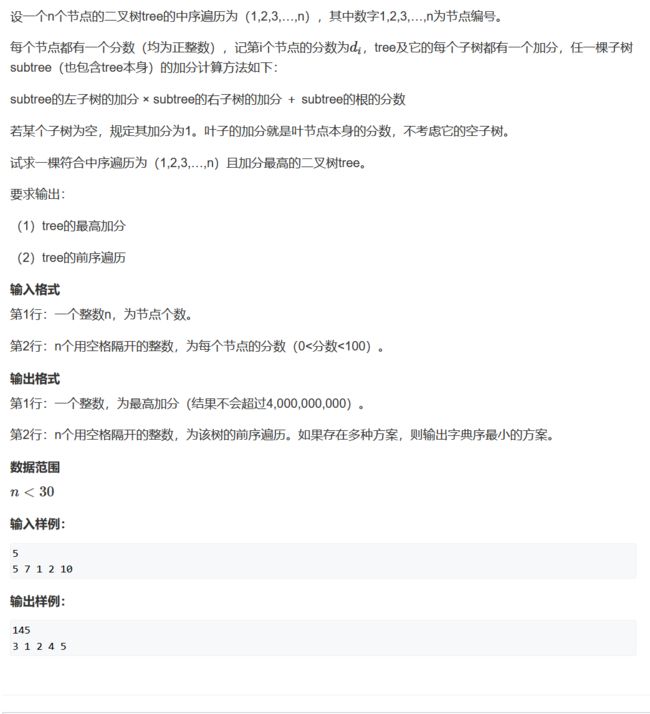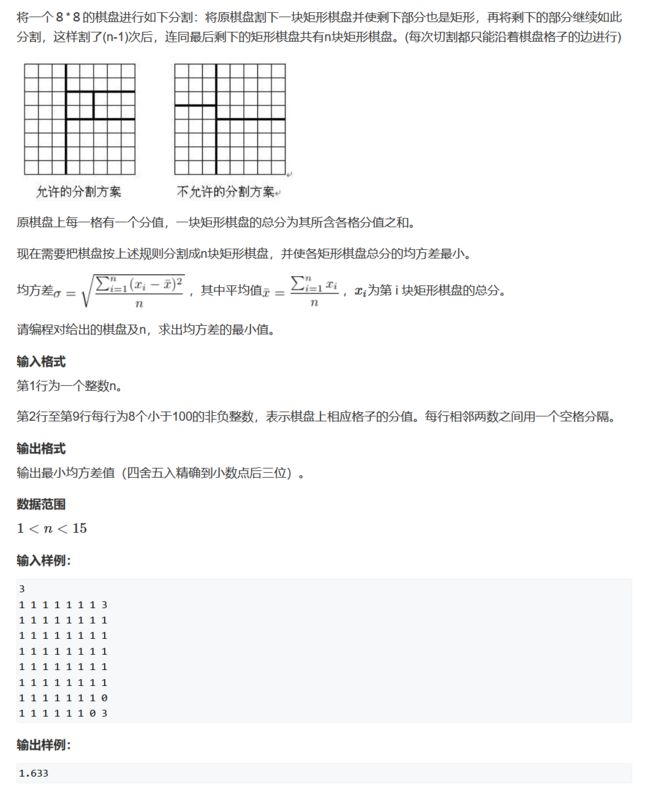第一章动态规划(十)
区间DP
例题:1068.环形石子合并
类比 282.合并石子
import java.util.Scanner;
public class Main {
static int INF = Integer.MAX_VALUE >> 1;
static int N = 410;//开两倍
static int n;
static int[] s = new int[N];
static int[] w = new int[N];
static int[][] f = new int[N][N];
static int[][] g = new int[N][N];
public static void main(String[] args) {
Scanner sc = new Scanner(System.in);
n = sc.nextInt();
for (int i = 1; i <= n; i++) {
w[i] = sc.nextInt();
w[i + n] = w[i];
}
sc.close();
//前缀和
for (int i = 1; i <= n * 2; i++) {
s[i] = s[i - 1] + w[i];
}
//初始化
for (int i = 0;i < f.length;i++) {
for (int j = 0; j < f[i].length; j++) {
f[i][j] = INF;
}
}
for (int i = 0;i < g.length;i++) {
for (int j = 0; j < g[i].length; j++) {
g[i][j] = -INF;
}
}
for (int len = 1; len <= n; len++) {
for (int l = 1; l + len - 1 <= n * 2; l++) {
int r = l + len - 1;
if (len == 1) {
f[l][r] = 0;
g[l][r] = 0;
}else {
for (int k = l; k < r; k++) {
f[l][r] = Math.min(f[l][r], f[l][k] + f[k + 1][r] + s[r] - s[l - 1]);
g[l][r] = Math.max(g[l][r], g[l][k] + g[k + 1][r] + s[r] - s[l - 1]);
}
}
}
}
int minV = INF;
int maxV = -INF;
for (int i = 1; i <= n; i++) {
minV = Math.min(minV, f[i][i + n - 1]);
maxV = Math.max(maxV, g[i][i + n - 1]);
}
System.out.println(minV);
System.out.println(maxV);
}
}
import java.util.Scanner;
public class Main {
static int N = 210;
static int n;
static int[] w = new int[N];
static int[] s = new int[N];
static int[][] f = new int[N][N];
static int INF = 0x3f3f3f3f;
public static void main(String[] args) {
Scanner sc = new Scanner(System.in);
n = sc.nextInt();
for (int i = 1;i <= n;i++) {
int x = sc.nextInt();
w[i] = x;
w[i + n] = x;
}
sc.close();
for (int len = 3;len <= n + 1;len ++) {
for (int L = 1;L + len - 1 <= n * 2;L ++) {
int R = L + len - 1;
f[L][R] = -INF;
for (int k = L + 1;k < R;k ++) {
f[L][R] = Math.max(f[L][R], f[L][k] + f[k][R] + w[L] * w[k] * w[R]);
}
}
}
int res = 0;
for (int i = 1;i <= n;i++) {
res = Math.max(res, f[i][i + n]);
}
System.out.println(res);
}
}
例题:凸多边形的划分
原题链接
【题目描述】
给定一个具有 N个顶点的凸多边形,将顶点从 1 至 N 标号,每个顶点的权值都是一个正整数。将这个凸多边形划分成 N−2个互不相交的三角形,试求这些三角形顶点的权值乘积和至少为多少。
【输入】
输入第一行为顶点数 N
第二行依次为顶点 1至顶点 N的权值。
【输出】
输出仅一行,为这些三角形顶点的权值乘积和的最小值。
【输入样例】
5
121 122 123 245 231
【输出样例】
12214884
【提示】
数据范围与提示:
对于 100% 的数据,有 N≤50,每个点权值小于 109 。
————————————————————————————————————————————————————
需要高精度
代码有错
import java.util.Arrays;
import java.util.Scanner;
public class Main {
static int N = 55;
static int M = 35;
static int INF = (int) 1e9;
static int n;
static int[] w = new int[N];
static long[][][] f = new long[N][N][M];
static long[] c = new long[M];
public static void main(String[] args) {
Scanner sc = new Scanner(System.in);
n = sc.nextInt();
for (int i = 1; i <= n; i++) {
w[i] = sc.nextInt();
}
sc.close();
long[] tmp = new long[M];
for (int len = 3; len <= n; len++) {
for (int l = 1; l + len - 1 <= n; l++) {
int r = l + len - 1;
f[l][r][M - 1] = 1;
for (int k = l + 1; k < r; k++) {
Arrays.fill(tmp, 0);
tmp[0] = w[l];
mul(tmp, w[k]);
mul(tmp, w[r]);
add(tmp, f[l][k]);
add(tmp, f[k][r]);
if (cmp(f[l][r], tmp) > 0) System.arraycopy(f[l][r], 0, tmp, 0, tmp.length);
}
}
}
print(f[1][n]);
}
private static void add(long[] a, long[] b) {
Arrays.fill(c, 0);
for (int i = 0, t = 0; i < M; i++) {
t += a[i] + b[i];
c[i] = t % 10;
t /= 10;
}
System.arraycopy(a, 0, c, 0, c.length);
}
private static void mul(long[] a, long b) {
Arrays.fill(c, 0);
long t = 0;
for (int i = 0; i < M; i++) {
t += a[i] * b;
c[i] = t % 10;
t /= 10;
}
System.arraycopy(a, 0, c, 0, c.length);
}
private static int cmp(long[] a, long[] b) {
for (int i = M - 1; i >= 0; i--) {
if (a[i] > b[i]) {
return 1;
}else if (a[i] < b[i]){
return -1;
}
}
return 0;
}
private static void print(long[] a) {
int k = M - 1;
while(k > 0 && a[k] == 0) k--;
while(k >= 0) System.out.print(a[k--]);
System.out.println();
}
}
import java.util.Scanner;
public class Main {
static int N = 50;
static int n;
static int[] w = new int[N];
static int[][] f = new int[N][N];
static int[][] root = new int[N][N];
public static void main(String[] args) {
Scanner sc = new Scanner(System.in);
n = sc.nextInt();
for (int i = 1; i <= n; i++) {
w[i] = sc.nextInt();
}
sc.close();
for (int len = 1; len <= n; len ++ ) {
for (int l = 1; l + len - 1 <= n; l ++ ) {
int r = l + len - 1;
for (int k = l; k <= r; k ++ ) {
int left = k == l ? 1 : f[l][k - 1];
int right = k == r ? 1 : f[k + 1][r];
int score = left * right + w[k];
if (l == r) score = w[k];
if (f[l][r] < score) {
f[l][r] = score;
root[l][r] = k;
}
}
}
}
System.out.printf("%d\n", f[1][n]);
dfs(1, n);
System.out.println();
}
private static void dfs(int l, int r) {
if (l > r) return;
int k = root[l][r];
System.out.printf("%d ", k);
dfs(l, k - 1);
dfs(k + 1, r);
}
}
f[x1][y1][x2][y2][k] : 将矩阵(x1,y1)->(x2,y2)分割成k个矩阵的最小方差
记忆化搜索:
import java.util.*;
class Main{
static int n, m = 8;
static double X, INF = 1e9;
static int[][] s;
static double[][][][][] f;
public static void main(String[] args){
Scanner sc = new Scanner(System.in);
n = sc.nextInt();
s = new int[m+1][m+1];
for(int i = 1; i <= m; i++){
for(int j = 1; j <= m; j++){
s[i][j] = sc.nextInt();
s[i][j] += s[i - 1][j] + s[i][j - 1] - s[i - 1][j - 1];
}
}
sc.close();
X = (double) s[m][m] / n;
f = new double[m + 1][m + 1][m + 1][m + 1][n + 1];
for(int i1 = 0; i1 <= m; i1++){
for(int j1 = 0; j1 <= m; j1++){
for(int i2 = 0; i2 <= m; i2++){
for(int j2 = 0; j2 <= m; j2++){
for(int k = 0; k <= n; k++){
f[i1][j1][i2][j2][k] = -INF;
}
}
}
}
}
System.out.println(String.format("%.3f", Math.sqrt(dp(1, 1, m, m, n))));
}
private static double dp(int x1, int y1, int x2, int y2, int k){
double t = f[x1][y1][x2][y2][k];
if(t >= 0) return t;
if(k == 1){
t = get(x1, y1, x2, y2);
f[x1][y1][x2][y2][k] = t;
return t;
}
t = INF;
for(int i = x1; i < x2; i++){
t = Math.min(t, dp(x1, y1, i, y2, k - 1) + get(i+1, y1, x2, y2));
t = Math.min(t, dp(i+1, y1, x2, y2, k-1) + get(x1, y1, i, y2));
}
for(int j = y1; j < y2; j++){
t = Math.min(t, dp(x1, y1, x2, j, k-1) + get(x1, j+1, x2, y2));
t = Math.min(t, dp(x1, j+1, x2, y2, k-1) + get(x1, y1, x2, j));
}
f[x1][y1][x2][y2][k] = t;
return t;
}
private static double get(int x1, int y1, int x2, int y2){
double sum = s[x2][y2] - s[x1 - 1][y2] - s[x2][y1 - 1] + s[x1 - 1][y1 - 1] - X;
return (double) (sum * sum) / n;
}
}




